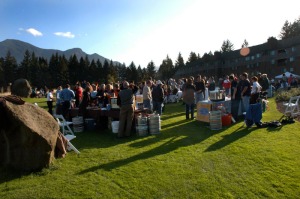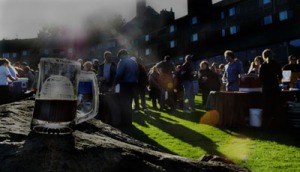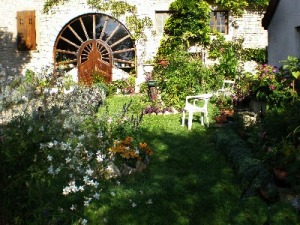I first met my English friends Bo and Helen Barcan on a ship sailing from Bergen, Norway to New Castle upon Tyne, Scotland. Cyclists, themselves, they knew what it was like to go more than a few days without a bath, and promptly and graciously offered up the shower in their compartment since the only water available in my compartment, in peasant class, was potentially ocean spray, and we’d have to encounter some pretty wild weather and rough seas for that to happen.
Further sealing our newfound friendship was their eagerness to prove to me that British food is a lot more than fish and chips (they too were vegetarians). When we parted ways at the ferry dock, I had their phone number and address securely penned in my address book, along with a standing invite to dinner if I ever made it to Bristol, in the south of England.
A month later, after cycling across Scotland along Hadrian’s Wall, ferrying across the Irish Sea, cycling around the perimeter of Ireland, sailing back across the Irish Sea, and, finally, cycling across Wales, I rolled up to the steps below the front door of their Westbury Park brownstone walk-up.
And thus began my British culinary and beer tour, which eventually launched me into the beer garden at Munich’s Oktoberfest.
In Scotland and Ireland, I temporarily became a piscatarian—a fish eating vegetarian—simply because I could not find enough nutritious veggie fuel to power my daily mileage of 60 to 75 miles. Fish and chip shops were everywhere, and I couldn’t resist the convenience of running in for a quick “take away” package of folded newspaper filled with greasy deep-fried cod and thin crispy potatoes.
I eagerly headed to Bo and Helen’s with hopes of putting an end to this artery-clogging habit.
In the days that followed, I was introduced to authentic Indian cuisine (for the first time in my so-called sheltered culinary life; it’s now my favorite ethnic food), home-prepared gourmet vegetarian meals and traditional English pub grub with some not so healthy vegetarian twists.
Chip Butty anyone? These little sandwiches consist of white bread, buttered and filled with piping hot chips and tomato sauce. In Ireland, I had already eaten way too much colcannon—boiled or steamed cabbage (or kale) mixed with mashed potatoes and cream. But that didn’t stop me from diving into a pile of the English version at a small pub in the English countryside. The Brits call it Bubble and Squeak (although,come to think of it, in Ireland, I had also heard people referring to this same dish as colcannon). In any case, if you’re not familiar with this British delicacy, it’s primarily sautéed cabbage or leftover vegetables, mixed with creamy mashed potatoes. The only way I could continue to eat this stuff nearly daily was to keep cycling (it’s amazing what you’ll eat when you’re famished).
The other thing I discovered in English pubs, something that is now widely commonplace in the U.S. (OK, this is aging me, but they weren’t widely used here at the time) were beer bar mats: the little card coasters advertising a brewery or brand. As a bike traveler, I found them to be ideal souvenirs due to their light weight, and, in fact, they soon became only the second thing I’ve ever collected in my life—apart from foreign postage stamps I horded as a kid. Over the years, I amassed a pile of both stamps and coasters from around the globe.
In the pubs, I also learned a thing or two about beer; enough to actually spark an interest that has stuck with me even today. In any case, I was gobsmacked to learn that beer, what the English call bitter, is served in pints at just under room temperature (ale, on the other hand, is beer made with hops and barley and is served at room temperature). The term for what we call beer in the U.S. is actually what Brits call lager. The beverage they actually call “beer” is dark ale served a bit below room temperature, not cold.
Got that?
I love the British lexicon, especially words like gobsmack (awesome, awed) blinkered (narrow-minded), bladdered (drunk), bugger (get off, shit, jerk, cheap), bollocks (no good), cheesed off (pissed off), shag (mutual sex), gormless (clueless) and “Bobs your uncle” (an expression I take to mean something like: “that’s it!”). These were productive days, indeed, for a writer with a life-long fascination with words borne out of my father’s insistence that I use a dictionary to look up the words I was always asking about in the days of my youth, much like I continue to do these days with an internet browser.
After all the beer and food, it was time to push off for the Portsmouth-Cherbourg ferry and take a 14-day detour in France, before finally arriving in Munich, just in time for the mother of all beer drinking events, Oktoberfest. An important part of Bavarian culture, more than 6 million people attend this massive beer fest every year—although only a small percentage are actually Bavarian; the rest mostly come from the U.S. and other western countries.
What began as a wedding celebration for the Bavarian crown prince Ludwig 1 to Princess Therese of Saxony on October 12, 1810, has morphed into the world’s largest “peoples’ fair.” Tradition prescribes that it runs during the 16 days up to and including the first Sunday in October.
Shortly after arriving in Munich, I visited the local visitor’s bureau, which quickly pointed out to me that with it being Oktoberfest season, and my having arrived without a hostel or hotel reservations, I only had one option remaining: Camping Thalkirken.
What a zoo. Imagine a pastoral, plebeian Burning Man camp flying the Teutonic flag rather than the freak flag.
Located in the Isar River Valley about a 15-minute bike ride from the city center, the 11-acre site holds 300 tents, 150 motorhomes and 100 dormobiles (campervans), and hundreds of partying campers during Oktoberfest, a place where the hardiest revellers sleep only a few wee hours before sunrise.
Camping Thalkirken is truly a crazy mini-city with every thing you need on site, including cooking facilities, a restaurant, and even a lounge (with televisions and table games). Less than 7-minutes from the tent sites, you’ll find a heated swimming pool and the Isar-Canal, frequently filled with an army of overly-intoxicated tubers. With tents spaced just a few feet apart, the only time the campground was even minutely quiet enough to catch some z’s was between 2am and 5am.
Just before sunrise, the entire campground would begin to fill with the hiss of igniting camp stoves, and the clatter of cooking and coffee pots as the revellers arose to make their way to Theresienwiese, located near Munich’s city center, to ensure their place at the front of the gate to, of course, be first in line for the beer tents.
Who the hell wants to drink beer at 8am? Apparently, from what I witnessed, a lot of Oktoberfestians.
So I don’t know what I was thinking, but I figured if the only way I was going to escape the lines and get into a beer tent without my own reservation, I too would have to head out at the crack of dawn. Also, seeing as it was the end of September and with daylight hours rather limited, I was bound and determined to stuff as much into one day as I could. (Note to self: that’s usually a mistake).
In the afternoon, I left my bike locked up at Oktoberfest and headed to Dachau by train.
Yep, that’s right: Dachua Concentration Camp, after a morning of beer sampling…yeah, real bright.
Dachau was a significant interment camp for a number of reasons. First used to imprison any German national who, for political, ideological, or racial reasons, was viewed as an adversary of the National Socialists, the SS later imprisoned Jews, Gypsies, Jehovah’s Witnesses and homosexuals at the camp. In addition to serving as a model for all later concentration camps, it also was used as a training camp for the SS. For 12 years, more than 200,000 people from across Europe were taken to Dachau and its subsidiary camps; 41.500 of them were slaughtered or summarily shot.
The modern day memorial site includes the former prisoners’ camp, the intake area, baths, and the crematorium. On April 29 1945, American troops liberated the survivors. My father was one of those troops, which is why I had long felt obliged and compelled to visit.
Next to the baths and the execution furnaces, the most difficult part of visiting this wretched memorial comes toward the end of the tour at the International memorial: A sculpture designed by Nandor Glid, a Yugoslavian artist who spent time in a forced labor camp during the war, strikes at the heart. The sculpture, a mash up of fence posts, barbed wire and a human skeleton, commemorates the many who in desperation committed suicide by jumping into the barbed wire fence that surrounded the camp. As you reach the end of the memorial, you come to a stout wall built with 36 stone blocks. Just in front of it sits a large square urn with the ashes of unknown concentration camp prisoners. The block wall holds the ironclad words: “Never Again,” written in Yiddish using Hebrew letters, and in French, English, German and Russian.
As I exited the camp that day, I felt like I had just experience the worst-best day of my life. It was the worst because it just killed me to think I lived in a world where something like this could happen. It was the best simply because I couldn’t think of an experience in my life that had ever moved me so deeply.
I headed back on the train to Munich with a mash up—like that sculpture—of emotions, feeling hollow and disheartened, depressed and empty; yet grateful and hopeful.
Back at Oktoberfest, I was no longer in the mood to deal with crowds or interested in beer sampling. Before I unlocked my bike and began the trek back to Camping Thalkirken, I grabbed a Radler—a half sprite and half beer beverage just inside the gate, and reflected on my day and just exactly what I had taken in.
As crazy and juxtaposed as these two experiences—Oktoberfest and Dachau—were, when considered side by side, I realized that this is exactly what I love about travel.
It’s not the same as a vacation where you mostly expect everything to be safe, easy and fun. Traveling is more about living in the present with all its inconsistency, risks and unknowns. In fact, the only constant when you’re living in the moment is change, which you must give yourself over to. To travel sanely, you have to stay open and present.
In retrospect, I think my rather rash uneducated decision to take on both of these uniquely German experiences on the same day was actually quite perfect. It definitely gave me an interesting perspective on Oktoberfest, which is another kind of human insanity in its on right, on its own scale.
Beyond the crowds—recent estimates put tbe number of annual visitors at 6.5 million—the volume of beer that flows inside the beer tents is staggering: some 7.1 million liters are consumed during the 16-day festival.
Another fascinating thing about Oktoberfest is that all the beer originates from breweries within Munich city limits. The goal is to get inside one of these breweries’ 14 beer tents and get your stein filled with one of six local beer brands.
The Armbrustschützenzelt (the “Crossbowman’s Tent,” named after a competition that’s been a part of Oktoberfest since 1895) is one of the bigger tents, with around 7,500 seats. Inside they serve beer that American beer aficionados are sure to recognize, Paulaner, a brewery established in the early 17th century in Munich, and named after Saint Francis of Paola, the founder of the Order of Minims.
The Löwenbräu-Festhalle—look for the tent/building featuring towers with lions sipping from beer steins on top—serves the also familiar Löwenbräu.
Bavarians and others who enjoy traditional (and authentic) Bavarian folk music head to the Augustiner tent, which pours the eponymous beer that some say is the best in Munich. Augustiner’s Oktoberfest and Edelstoff are the only beers at the festival that are still served from traditional wooden barrels.
Besides the beer, many also come to Oktoberfest to partake of the wide variety of traditional foods offered: hendl (chicken), ochsen (ox), steckerlfisch (grilled fish on a stick), schweinebraten (roast pork), würstl (sausages), brezn (pretzels), knödel (potato or bread dumplings), reiberdatschi (potato pancakes), kasspatzn (cheese noodles), sauerkraut and blaukraut (fermented green and red cabbage), and always a few Bavarian dairy and meat delicacies including obatzda (a spiced cheese-butter spread) and weisswurst (a white sausage).
If there was one thing I owe to my Oktoberfest experience it is that it opened me up to the possibility of visiting an American beer festival. Had I not been to the largest in the world, I don’t think I would have been very interested in a beer gathering. I’m fairly discerning when it comes to partaking of a public party, but now I feel very lucky: two of my two favorite beer fests happen to be very close to home.
And the thing I’ve noticed is that most of the beer drinkers at these events aren’t there to tie one on. Some come to collect a beer mat or two to help remind them later which brew they loved best, in the same way serious wine tasters make notes when they find a new wine they enjoy. But most come simply to try something new and meet like-minded people.
In England, you toast Cheers! In Ireland, it’s Slainte! In German, Prost! And here in American, just about anything goes, including “Nice to meet you!”
Celebration of Beer Weekend at Skamania Lodge in Stephenson, Washington
10/08/2011 to 10/09/2011
Now in its third year, and well on its way to becoming a perennial favorite for Northwest beer lovers, Skamania Lodge’s Celebration of Beer fest offers a terrific opportunity to taste a perfectly sized selection of great Northwest beers from top craft brewers like Amnesia, Full Sail, Fish (awesome organic beer), Lompoc, Salmon Creek, Prodigal Son, Laht Neppur, Snipes Mountain, and Yakima Craft breweries, as well as one of my all time favorite ales: Walking Man.
Unlike wine, tasting and dumping isn’t the usual modus operandi. Use your tickets carefully. Try a small ounce or two, and when you find something that really turns you on, go ahead and use more tickets to get a full pour.
To really enjoy the full scope of this event, eat while you taste and book a room in advance so you don’t have to drive; Skamania Lodge offers an awesome packages that includes lodging, tickets for food and beer, two keepsake beer mugs, and the beer-centric Kegs and Eggs Buffet on Sunday. Tickets to the beer tasting are sold at the door: $20 for 20 tickets and a mug or $40 for 50 tickets and 2 mugs
On Saturday, from noon to-1pm, attend Beer School, led by Full Sail Brewery’s head brewer Jamie Emmerson, and learn what the elements are that makes beer taste so good.
From 1pm to 5pm, savor, sample and, vote for your favorite brew. After 3pm, brewers roll out their seasonal or unreleased beers for tasting. From 5pm to 9pm enjoy an Oktoberfest Buffet in the Cascade Dining Room, featuring a special menu of beer themed foods prepared from beers from the tasting an with. $34.95 per person.
On Sunday, October 9, from 9am to 2pm., enjoy Skamania’s famous Sunday Brunch featuring all the traditional favorites, as well as a sampling of foods from across the Pacific Northwest. $28.95. Contact Information
Oregon Brewers Festival
July 26-29, 2012
If you love micro-brewed or craft beer, this is your festival. Always held the last full weekend in July, 2012 Marks the 25th anniversary of this iconic brewfest. The top craft beer festival in the U.S., it’s also one of the nation’s longest running. Some 80,000-beer lovers converge of this 4-day event, sampling 20 styles of award-winning craft beer poured by 80 craft breweries from across the country. The “Buzz Tent” offers another 50-plus rare and specialty beers. In addition to beer tasting, there is a line up of live music, as well as beer-related vendors, beer memorabilia displays, beer home-brewing demonstrations, and an assortment of food available.
Taps are opened at noon and shut-off at 9pm on Saturday; Sunday until 7 pm. Admission to the festival grounds is free, but if you want to taste beer, buy a souvenir mug for the current festival year ($6). Beer is purchased with wooden tokens, priced at a buck apiece. Patrons pay four tokens for a full mug of beer, or one token for a taste. Free handcrafted root beer is served in the Crater Lake Root Beer Garden for minors and designated drivers.
By the way, stay super safe and take the bus, a taxi or MAX Light Rail (located just one block west of the festival on SW Oak Street). The festival also offers free, on-site bicycle parking Contact Information





